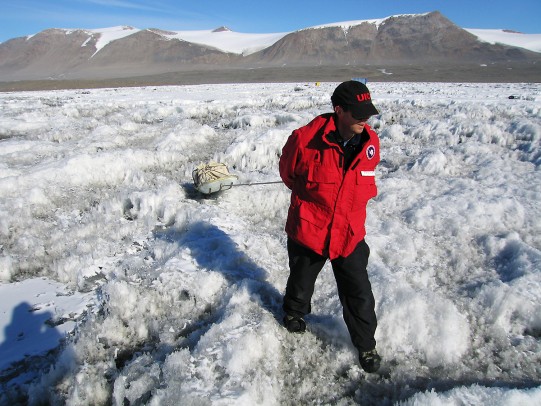Chicago’s temperatures colder than Antarctica

Peter Doran conducts research in Antarctica. Doran returned from the continent Sunday to find colder temperatures in Chicago.
When UIC scientist Peter Doran returned from his trip to Antarctica Sunday, he came home to temperatures in Chicago that were colder than on the frigid continent.
The reason: the polar vortex pushed subzero temperatures from the Earth’s geographical poles to the Chicago area.
“There are strong upper level winds that circle the Earth and keep the cold air in the Arctic and Antarctic,” said Doran, professor of earth and environmental science.
“What’s happening this week and earlier this month is that pieces of the vortex sort of broke off and headed south, so you get this cold Arctic air coming off.”
If you look at a world temperature map this week, you’ll find that the Arctic and Arctic regions are “incredibly warm,” Doran said — Tuesday’s forecast in Anchorage, Alaska, was 40 degrees.
Temperatures in Antarctica during Doran’s four-day trip there hovered around the freezing mark, considerably warmer than Chicago’s subzero temperatures.
Doran was in Antarctica to give a report to a National Science Foundation review team about his research on the continent.
Doran, who studies life in extreme environments, was principal investigator on a recent study that discovered abundant and diverse bacteria thriving in the brine of an Antarctic lake sealed for millennia under 65 feet of ice.
Doran often conducts his research there around this time of year, when it’s summer on the continent and temperatures are generally in the 30s.
“People always say, ‘Poor you, going to Antarctica,’ but it’s almost always warmer there,” he said.
Doran also examines the impact of climate change.
More data is necessary to point to global warming as the cause of the unusually cold weather in Chicago, he said, because other factors such as El Nino weather patterns could also play a role.
“The polar vortex is part of a natural cycle,” he said.
However, “two of these really big outbreaks in the same winter is really very unusual.”
Still, winters in Antarctica are far worse than Chicago’s short-lived frigid spells — highs range from -40 to -80, and that doesn’t include wind chill, Doran said.
“With wind chills, the skin feels the temperature differently but it’s still the same temperature,” he said.
“The wind is hitting your skin and the water on your skin is evaporating so it gives it an even cooler feel.”
